Rumored Buzz on Hilton Head Landscapes
Table of ContentsSome Known Details About Hilton Head Landscapes See This Report about Hilton Head LandscapesTop Guidelines Of Hilton Head LandscapesExamine This Report on Hilton Head LandscapesSome Ideas on Hilton Head Landscapes You Need To KnowThe Facts About Hilton Head Landscapes UncoveredSome Known Questions About Hilton Head Landscapes.Examine This Report on Hilton Head Landscapes
Kind compatibility is likewise a significant part of unity in designone or 2 strikingly various types benefit comparison and emphasis, yet typically all other types should have some similarities for a combined look. Appearance describes just how rugged or fine the surface of the plant or hardscape product really feels and/or looks.
Instances of plants with coarse structure include philodendrons, agaves, bromeliads, hollies, hands, and hydrangeas. Hardscape with rugged texture includes rough-cut rock, rough-finished brick, and incomplete timber with knots and an increased grain. Matured or old building and construction product that preserves a weather-beaten surface area is usually rugged in structure. Qualities that create great structure consist of tiny foliage; slim, strappy leaves (grasses) or high, slim stems; small, thick twigs and tiny branches; long stems (vines); and small, fragile blossoms.
Some Known Questions About Hilton Head Landscapes.
The majority of plants are medium structure, because they can not be called having either coarse or fine structure. They are identified by medium-sized leaves with easy shapes and smooth sides. The average-sized branches are not largely spaced neither widely spaced, and the overall form is normally rounded or mounding. Medium-textured plants function as a history to web link and link the rugged- and fine-textured plants.

To make a space really feel smaller, put the coarse appearances along the external border and the great structures closest to the visitor. The information of the crude appearance makes the plants show up closer and makes the room feel smaller. The regarded appearance of plants can additionally transform with the range from the plant.
The Basic Principles Of Hilton Head Landscapes
Strong shades enhance the contrast and make the texture appear coarser, while muted shades can flatten texture. Hardscape with a coarse texturesuch as really rough rocks and bold, big timberstends to make all plant product appear much more medium distinctive. Designers frequently establish an appearance study (Number 8) theoretically to aid choose the arrangement of plant materials.
Figure 8. Texture research. Color in plant product and hardscape adds interest and selection to the landscape. Color is the most conspicuous element in the landscape and is usually the emphasis of many home owners; nevertheless, it is additionally one of the most short-term element, generally lasting just a couple of weeks a year for private plants.
Not known Factual Statements About Hilton Head Landscapes
An easy description of the color wheel consists of the three primary colors of red, blue, and yellow; the 3 secondary shades (a mix of 2 primaries) of green, orange, and violet; and six tertiary colors (a mix of one nearby key and secondary color), such as red-orange. Color theory discusses the connection of shades to each various other and exactly how they need to be used in a make-up.

Comparable (in some cases called harmonious) color pattern are any 3 to 5 colors that are adjacent on the color wheel, such as red, red-orange, orange, yellow-orange, and yellow, or blue, blue-violet, and violet (Landscapers near me). The shades relate to each other because they usually consist of 2 primaries mixed to form a secondary and two tertiary colors, which indicates they share usual buildings
Complementary shades are typically discovered normally in blossoms; a typical set is yellow and violet. Shade is discovered in the flowers, vegetation, bark, and fruit of plants.
Getting My Hilton Head Landscapes To Work
Green foliage in all its various tones is the dominant shade by amount, but other colors catch interest much more easily due to the fact that of their high contrast to the shade green. Color is likewise found in buildings, rocks, pavers, wood, and furnishings. A lot of colors in natural materials, such as stone and wood, are usually low-key and tend to be variations of brown, tan, and pale yellow.
Shades have residential or commercial properties that can impact emotions, spatial understanding, light quality, equilibrium, and focus. Awesome shades tend to be soothing and must be made use of in areas for relaxation and peacefulness.
About Hilton Head Landscapes
Trendy colors have a tendency to recede and are viewed as being farther away, making a space feel bigger. Color can additionally be utilized to record focus and direct sights.
As an example, intense yellow, which has the highest possible strength, also has a high contrast with all various other colors (typically explained as a "pop" of color) and need to be conserved. A percentage of intense shade has as much visual weight as a large amount of an extra subdued or weak color.
Similar (often called harmonious) color systems are any kind of 3 to 5 colors that are nearby on the shade wheel, such as red, red-orange, orange, yellow-orange, and yellow, or blue, blue-violet, and violet. The colors belong to every other because they commonly consist of two primaries mixed to develop a second and 2 tertiary shades, which means they share typical homes.
Hilton Head Landscapes Fundamentals Explained
They often tend to have high comparison between them. One of the most usual sets are violet and yellow, red and environment-friendly, and blue and orange. Corresponding shades are often located normally in flowers; an usual pair is yellow and violet. Color is located in the flowers, vegetation, bark, and fruit of plants.
Environment-friendly foliage in all its different tones is the dominant shade by quantity, yet other shades record focus much more readily due to their high comparison to the color green - Visit Website Landscapers near me - https://gravatar.com/stevenagonzales. Color is likewise discovered in structures, rocks, pavers, timber, and furniture. The majority of colors in natural materials, such as rock and timber, are normally muted and have a tendency to be variants of brown, tan, and light yellow
6 Simple Techniques For Hilton Head Landscapes
Colors have buildings that can influence feelings, spatial understanding, light high quality, equilibrium, and focus. Great colors tend to be soothing and should be used in areas for relaxation and serenity.
Amazing shades have a tendency to recede and are perceived as being further away, making a space really feel larger. Shade can likewise be utilized to capture focus and direct sights - https://padlet.com/stevenagonzales/my-delightful-padlet-65fq7sgb974pr3v2.
For instance, intense yellow, which has the highest strength, also has a high comparison with all other shades (frequently described as a "pop" of color) and must be utilized moderately. A small quantity of extreme color has as much visual weight as a large quantity of a more subdued or weaker shade.